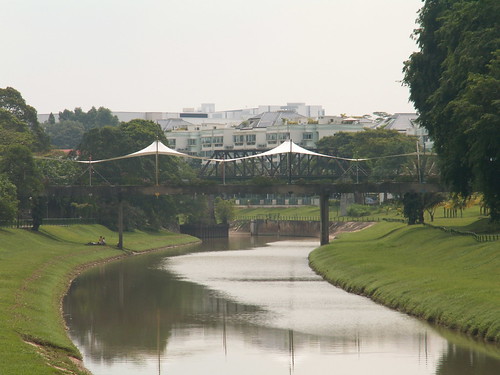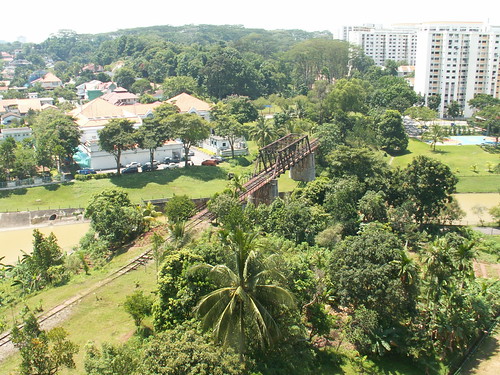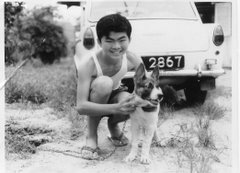The two photos below were scanned from the book, Singapore, An Illustrated History, 1941 ~ 1984, Information Division, Ministry of Culture. Top photo notes read: Members of the Second Battalion Singapore Infantry Regiment (SIR) in the jungles of Johor, Malaysia. The SIR was deployed to combat armed Indonesian infiltrators in Malaysia. Bottom photo notes read: An ambush by the Indonesians at Kota Tinggi led to the deaths of eight SIR soldiers. Suspected Indonesian infiltrators are escorted from a mangrove in Pasir Panjang on 29 December 1964. Local security forces working in close cooperation with British forces succeeded in rounding up many infiltrators and saboteurs and in keeping terrorism generally under control.

***************************************************
As a NS recruit, I did not know much about the Kota Tinggi details but later as a staff officer I had the opportunity to meet these personnel from 2SIR during the usual Friday Tombolo Night.
At that time when Singapore was a part of Malaysia our two SIRs were renamed as 1MIR and 2MIR. 2SIR was operationally responsible for the Singapore and southern Johore area. 2MIR (2SIR) was raised in 1962 and billeted at Holland Road Camp.
According to my superior who was then a young 2LTA in 2 SIR, Dalgit Singh was already a platoon commander, together with LTA Mejar Singh. 2SIR's CO was a Colonel Campbell, a British seconded from the British Army.
It was the crack Indonesian paratroopers from the "KKI", an elite Guards unit from Jakarta which was sent on this mission. The Malaysian police post at Kota Tinggi were alerted of the parachute-landing and the nearest infantry garrison to Kota Tinggi was 2 SIR in Singapore. 1SIR at that time was deployed to the Sabah border with Indonesia.
One platoon of 2SIR was sent inside the jungles of Kota Tingi. For those who have ventured into Kota Tinggi (which I did as a child and as a teenager), it has a waterfall as the key attraction. The killing zone was north of the waterfall.
2SIR made no contact with the Indonesians for about a week. However, unknowingly the Indonesians were tailing one of the SIR sections. Not finding them for a week, that section grew tired and went for a bath at one of the nearby Kota Tinggi streams. Everybody left their weapons at the riverbank with no personnel on sentry-duty.
For those trained in the SAF doctrine, you are not supposed to do this and at all times, your rifle must be with you. The Indonesians pounded on our boys but one injured personnel managed to sneak away and ran for his life into Kota Tinggi Town. All this time, there was "radio silence" because this was a mission. It was only after the injured personnel emerged from the jungle that the incident became known. When the dead were recovered, their bodies were infested with maggots and were very gruesome
Reinforcements were rushed up from Singapore. On that mission were names like James Teo (who was the 5SIR CO for BERSATU PADU in 1971), Jimmy Yap (CO Officer Cadet School), Mahinder Singh (Dy Director SAFTI) and Dalgit Singh (CO 3SIR). They were “young lieutenants” then. James Teo was the unit signals officer. This time, the Indonesians scattered in different directions. It must have been somewhat of a surprise that no Indonesians were caught alive. I leave it to you to guess what must have happened next because I saw some of the photographs taken at that time. Don't forget our jungle-weapons also included the machete. The two Singhs were later involved in the Labis incident and again credited with many enemy killings.
The decomposed bodies were brought back to Holland Road Camp for the Malay burial rituals. The slain men were given a full-military burial.
 Photo of the funeral at Bidadari Muslim Cemetery. Men wearing songkok were Malaysian regulars working side by side with their Singaporean counterparts in 2 SIR
Photo of the funeral at Bidadari Muslim Cemetery. Men wearing songkok were Malaysian regulars working side by side with their Singaporean counterparts in 2 SIR
##Akan Datang (Coming soon): The bridge that I 'blew up' twice - Lam Chun See
Related Posts:
1) The Famous Kota Tinggi-2SIR Incident Part 1
2) The Famous Haunted Camp
 So thanks to Gordon, you will be able to learn a bit about the history of one of the few remaining British army camps in Singapore. Thanks to contribution from Gordon and other readers, I shall be able to start a new series about old British Army camps in Singapore.
So thanks to Gordon, you will be able to learn a bit about the history of one of the few remaining British army camps in Singapore. Thanks to contribution from Gordon and other readers, I shall be able to start a new series about old British Army camps in Singapore. In 1957 when I arrived at the unit, there were 4 tents in front of the barrack block. We spent the first month in tents. The mosquitoes were hell! The 1957 photo shows 3 tents, so the one I was in had been removed and I had graduated to the barrack building.
In 1957 when I arrived at the unit, there were 4 tents in front of the barrack block. We spent the first month in tents. The mosquitoes were hell! The 1957 photo shows 3 tents, so the one I was in had been removed and I had graduated to the barrack building. I hope the enclosed is of interest and would like to hear from you. I am hoping to make a trip to Singapore before I get much older to see several sites I did not see whilst in service.
I hope the enclosed is of interest and would like to hear from you. I am hoping to make a trip to Singapore before I get much older to see several sites I did not see whilst in service.
 Photo 1: View from Clementi Block 307 showing the Jurong Line as it crossed the Sungei Ulu Pandan
Photo 1: View from Clementi Block 307 showing the Jurong Line as it crossed the Sungei Ulu Pandan Photo 2: Various parts of the Jurong Industrial Estate were served by the Jurong Line
Photo 2: Various parts of the Jurong Industrial Estate were served by the Jurong Line Photo 3: The “ends” of the Jurong Line
Photo 3: The “ends” of the Jurong Line Photo 4a: Jurong Station Signage in recent years
Photo 4a: Jurong Station Signage in recent years Photo 4b: The same Jurong site some decades earlier. The time-keeper’s hut is visible
Photo 4b: The same Jurong site some decades earlier. The time-keeper’s hut is visible Photo 4c: A 1993 map showing the location of the SBS depot at Jurong Port Road
Photo 4c: A 1993 map showing the location of the SBS depot at Jurong Port Road


.JPG)
 Picture 3: PDF soldiers coming out of Maju Camp to main Clementi Road. This place is directly opposite the future Corona Florist nursery.
Picture 3: PDF soldiers coming out of Maju Camp to main Clementi Road. This place is directly opposite the future Corona Florist nursery. Picture 4: Old entrance to Maju Camp marked by road block pillars.
Picture 4: Old entrance to Maju Camp marked by road block pillars.  Photo 5: Down in the valley, the old railway track is still visible to the eye
Photo 5: Down in the valley, the old railway track is still visible to the eye








 Cadet C S Lam meticulously cleaning his precious AR-15
Cadet C S Lam meticulously cleaning his precious AR-15 Photo of a stripped AR-15 displayed at the Army Museum by
Photo of a stripped AR-15 displayed at the Army Museum by .jpg) One of the buildings of the camp complex viewed from the main road. Some renovation was going on. I wonder what they are converting this place into. Anyone know?
One of the buildings of the camp complex viewed from the main road. Some renovation was going on. I wonder what they are converting this place into. Anyone know?.jpg) This is the spot along Old Holland Road where a small road led into the camp. On the way, there was a ’new’ squash court on the left.
This is the spot along Old Holland Road where a small road led into the camp. On the way, there was a ’new’ squash court on the left.
.JPG) This is a recent shot of the place where 2 SIR used to stand.
This is a recent shot of the place where 2 SIR used to stand.+-+From+Mt+Sinai+View.JPG) This is a recent shot taken from Mount Sinai View of the hill where 2 SIR used to stand. In those days, there were less tall trees and the camp buildings could be seen quite clearly.
This is a recent shot taken from Mount Sinai View of the hill where 2 SIR used to stand. In those days, there were less tall trees and the camp buildings could be seen quite clearly. Photo shows where Ulu Pandan Road (left) joins Holland Road (right)
Photo shows where Ulu Pandan Road (left) joins Holland Road (right) This is the part where the Old Holland Road was truncated. That short stretch behind the barrier used to lead all the way to the Bukit Timah Road via a winding route that passed through thick vegetation. I used to jog here quite often.
This is the part where the Old Holland Road was truncated. That short stretch behind the barrier used to lead all the way to the Bukit Timah Road via a winding route that passed through thick vegetation. I used to jog here quite often.
.JPG)

.JPG)
.JPG)
 Fig 2: One of the pre-WW2 buildings at the highest point of Mowbray Camp (circa 1958). It was used as a football pitch but the SAF converted that into a “Parade Square”. The secret tunnel was somewhere around that building
Fig 2: One of the pre-WW2 buildings at the highest point of Mowbray Camp (circa 1958). It was used as a football pitch but the SAF converted that into a “Parade Square”. The secret tunnel was somewhere around that building Fig 3: Gurkhas and their guard dogs
Fig 3: Gurkhas and their guard dogs


 Fig 2A: The swimming pool at Pandan Valley (circa 1979)
Fig 2A: The swimming pool at Pandan Valley (circa 1979) Fig 3: The hills opposite 1SIR which would become the future Pandan Valley (circa 1958)
Fig 3: The hills opposite 1SIR which would become the future Pandan Valley (circa 1958) Fig 1: A military burial ceremony at the main entrance to the cemetery. The view is from the cemetery towards Ulu Pandan Road.
Fig 1: A military burial ceremony at the main entrance to the cemetery. The view is from the cemetery towards Ulu Pandan Road.  Fig 2: The graves and the chapel in the background
Fig 2: The graves and the chapel in the background Fig 3: The small chapel on the left of the main entrance. Beyond the gate were the graves. The old chapel could be on the slope of the Pine Grove main entrance
Fig 3: The small chapel on the left of the main entrance. Beyond the gate were the graves. The old chapel could be on the slope of the Pine Grove main entrance




